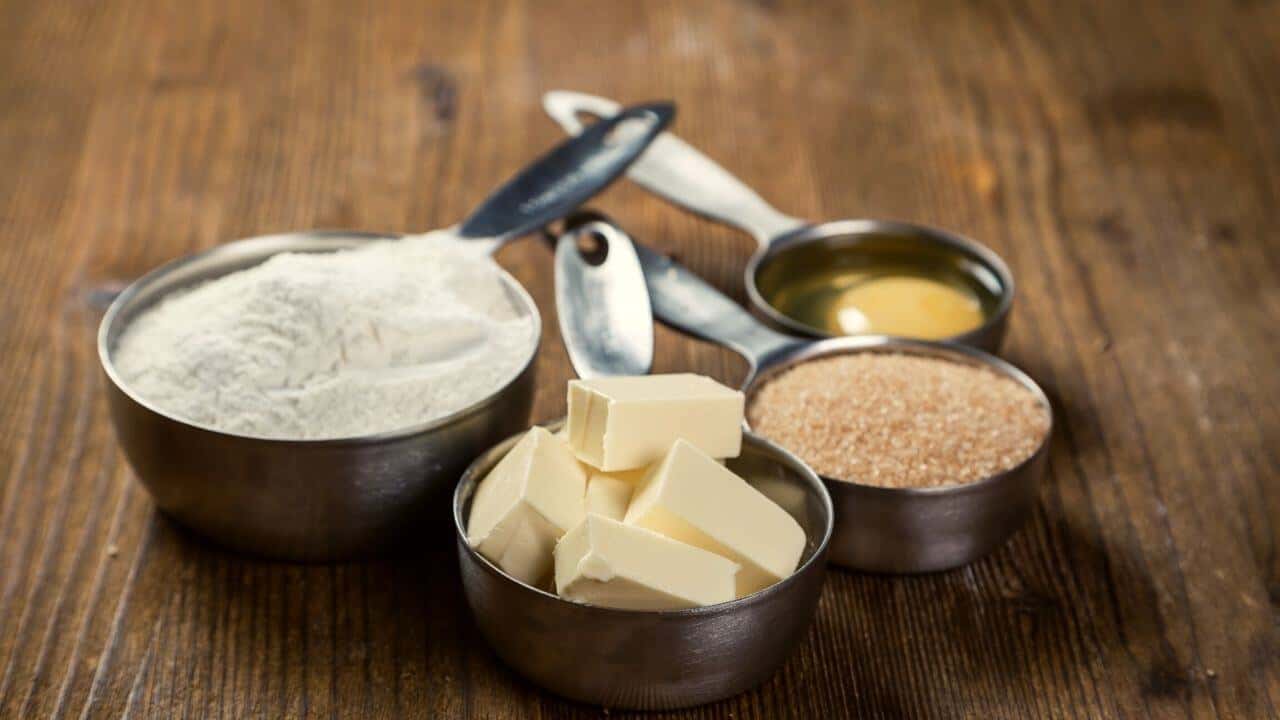Last Updated on May 19, 2023 by River Tree Farms
When baking, cooking, or making a smoothie, you have to be careful with your measurements. Even the slightest error could affect the final outcome. It would be best if you had standard-size measuring cups and spoons for accuracy. But what happens if you don’t have those? It would be best if you learned how to improvise. Here is how to measure ¾ cup without a measuring cup.
Measuring 3/4 Cups Without a Measuring Cup
The simplest tip is using a tablespoon. A cup of dry ingredients is equal to about 16 tablespoons. Therefore, ¾ cup would be about 12 tablespoons. While this isn’t the most precise measurement, it works.
If you need to be very accurate, measure your ingredients by weight. Using a kitchen scale to measure without measuring cups could save you lots of time.
Measuring Ingredients Without a Measuring Cup
Here is a guide to help you get accurate measurements without dry measuring cups.
1. Size Comparison
When you don’t have a measuring cup, consider estimating the size of your measurements. If you cook or bake a lot, you can easily visualize estimates. Here are a few examples to keep in mind:
- A tablespoon is about the size of an ice cube
- A teaspoon is roughly half of a tablespoon
- ¼ a cup is the size of a large egg
- One cup is the size of a baseball
- Half a cup is about the size of a tennis ball
Using a transparent container may be a good idea. It lets you get familiar with different sizes and volumes.
2. Use Tablespoons and Teaspoons
Measuring with tablespoons and teaspoons might take up a lot of time, but it is a good idea. One cup is equal to about 16 tablespoons. If you need half a cup of liquid ingredients, measure about eight tablespoons.
A teaspoon is about 4.7 ml. When using it to measure liquid ingredients, pour slowly and hold your spoon over a container to avoid creating a mess. Here are other volume measurements to keep in mind:
- One teaspoon is about five milliliters
- ½ cup equals eight tablespoons or 118 milliliter
- One quart is approximately 946 milliliters, two pints, or almost a liter
- A tablespoon is equal to three teaspoons and 15 milliliters
- A quart equals almost two liters or two pints
- ¼ cup equals four tablespoons or 59 milliliter
- A gallon equals four quarts or 3,785 milliliter
- One pint equals two cups or 473 milliliters
3. Use a Kitchen Scale
Use your kitchen scale to measure both solid and liquid ingredients. For accuracy, start by weighing your container. Press zero to ensure that the container’s weight appears as zero.
Pour in the ingredients and stop when you reach the desired weight or volume. This is arguably one of the most accurate ways of getting measurements. Some kitchen scales have options for different liquids.
4. Use Your Hand
Did you know that you can take measurements with nothing but your hand? It is one of the best ways of measuring dry ingredients when you don’t have measuring cups or spoons. However, it calls for some practice. Newbies may be unable to get accurate measurements using their hands.
If you cook or bake often, you should be able to easily estimate quantities of rice, salt, flour, and sugar. Here are a few other ways to make estimates with your hand:
- Two pinches with your middle finger, thumb, and forefinger are equal to ¼ teaspoon
- One pinch with your thumb, middle finger, and forefinger equals 1/8 teaspoon
5. Use a Cloth
If measuring with your hands seems too complex, consider using a piece of cloth. Spread it out on a flat surface and pour cups of flour in different quantities. You can also pout other ingredients in different quantities.
This strategy will give you a mental impression of different sizes for future reference. You can, therefore, use the piece of cloth for different measurements in the future.
6. Use a Bowl
Try using a bowl to get an impression of how different measurements look. Bowl measurements are just like clothes. Measure one cup of ingredients and pour it into a bowl. In the future, you may be able to take measurements without a measuring cup.
The Different Types of Measuring Cups
There are two main kinds of nearing cups: dry and wet. Avoid mixing them up when measuring your ingredients as you may interfere with the flavors and final result. This is most important when baking. Most baking recipes require utmost precision.
However, you may find measuring cups meant for measuring both dry and liquid ingredients. They have calibration on the opposite sides for precision.
1. Liquid Measuring Cups
These cups may have one to four cup measurements. They are made from clear material so you can get a clear view of all your measurements. The cups have spouts that make it easy to pour liquids out.
Some liquid measuring cups have oval rings inside. They are slanted to the sides for proper viewing. They are perfect for measuring honey, milk, syrup, and water.
2. Dry Measuring Cups
These measuring cups are designed for nuts, sugar, and flour ingredients. Most of them come in sets of different sizes. They may be made from plastic, metal, or glass.
How to Take Accurate Measurements
Your ability to take precise measurements ultimately affects the results of your cooking. Here are a few tips to improve the accuracy of your measurements.
1. Be Careful With Sticky Ingredients
Honey, peanut butter, and other sticky ingredients can be difficult to measure. Things are likely to get messy in the kitchen. You can avoid the issue by dipping your measuring cups and spoon in vegetable oil or hot water first. Measure your ingredients without drying the cups or spoons.
Alternatively, you can apply a coat of cooking spray to your measuring cup first. You’ll have an easy time getting the ingredients from your measuring cup or spoon.
2. Use the Right Measuring Cups
Choose between dry and liquid measuring cups depending on your ingredients. Although estimates work, having the right cups is better. Use specific cups for specific measurements.
When measuring dry ingredients, ensure that your scoops are level.
Instead of scooping flour and other powdery ingredients, fill your cups with spoons. Direct scooping is more appropriate for salt and other heavy ingredients. Ensure that the lower meniscus touches the exact mark when measuring liquid ingredients.
3. Beware of Air Pocket
Ensure that there are no air pockets when taking measurements. Be especially careful with brown sugar, which is mostly moist. Pack it down instead of scooping directly to get rid of air pockets.
Consider using the back of a spoon to pat it until you get the top of the cup. Level it out to take the shape of your cup.
4. Use a Scale
Scales are perfect for ensuring accuracy in your measurements. They let you measure ingredients in fluid ounces, grams, ounces, or milliliters. Kitchen scales are ideal if you bake a lot. The accuracy yields consistent results.
Alternative Units of Measurement
There are other ways to measure your kitchen ingredients. If you don’t have a measuring cup, consider using them to make estimates.
1. Pinch
This unit of measurement is ideal for salt and other dry ingredients. All you need to do is pinch your forefinger and thumb. A pinch equals about 1/16 of a regular teaspoon.
2. Heaping
This unit of measurement is used in reference to quantities that heap over a cup or spoon.
3. Dash
This unit may be used to measure both dry and liquid ingredients. It is equal to three liquid drops. It is more than 1/16 of a teaspoon but less than 1/8.
4. Scant
This means slightly less than the actual measurement. A tablespoon scant, for example, means slightly less than a regular tablespoon.
Read More:
How Much Is A Scoop Of Formula?
Conclusion
Are you wondering how to measure 3/4 cups without a measuring cup? Your options are endless. Having a measuring cup in your kitchen is a great idea. It promotes the accuracy and saves you time. However, your cooking doesn’t need to stop just because you don’t have the right measuring cup.
Consider measuring your ingredients with a kitchen scale, spoons, or your hands. In addition, you can take estimates with a bowl or piece of cloth. If you have been cooking or baking for a long time, you can easily make estimates. You’d also be wise to understand alternative units of measurement. They include pinch, dash, and heaping.

